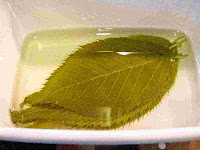<Ingredients>
2 tsp shiratamako sweet rice powder
4 tbsp flour
2 1/2 tsp sugar
5 tbsp water
Tiny amount (fingernail-size) beet
1-2 tsp water (to add to grated beet; not in photo)
130-15 0g tsubuan or koshian sweet azuki paste (tsubuan in photo)
5 sakura no ha no shiozuke salted cherry leaves
<Directions>
1.
If using tsubuan, puree, cover, and let sit for 1 hour.
2.
In a bowl, put shiratamako and 1 tbsp water, and mix well.
Shiratamako has small lumps, so try to mash them up, and blend with water.
Add sugar, mix, add remaining water, and mix.
Sift in flour, and mix well.
3.
Grate beet. You only need 1/2 tsp or so of grated beet.
Add 1-2 tsp water.
4.
Add 3/4 tsp (1/2 tsp + 1/4 tsp) beet water through a strainer into batter, and mix well.
Cover, and let sit for 1 hour.
(Batter becomes smoother after 1 hour.)
5.
If pureed azuki paste looks soggy, microwave for a short time (30-40 seconds).
Azuki paste becomes drier when cooled, so stop microwaving when it still looks and feels moist.
Form five balls of azuki paste, and set aside. (Cover if not immediately making crepes for sakuramochi.)
6.
Soak salted cherry leaves in water for 5-10 minutes (or longer if a less salty taste is desired).
Place cherry leaves with their back side up on a towel or paper towel to lightly dry the top side.
Leave the back side moist.

Cut off petiole.
7.
Place a silicon mat or silicon-coated cooking paper on a flat microwaveable plate, and put 1 1/2 tbsp batter in an oval shape.
Microwave for 50-60 seconds.

8.
When cool enough to handle (5-10 seconds after removing from microwave), peel off crepe.
Place azuki paste ball in center, and fold crepe.
Wrap with cherry leaf with the back (moist) side facing out.
The other common shape is to roll the crepe completely.
Place azuki paste on crepe, and roll.
Wrap with cherry leaf with the back side facing out.
<Notes>
- The vein pattern of cherry leaves is regarded as pretty, so when wrapping sakuramochi, leaves are used with the back side facing outward, as the vein pattern is more visible on the back side.
- Koshian, a very smooth azuki bean paste made by putting boiled azuki through a sieve, is typically used for sakuramochi. Pureed tsubuan is not as smooth as koshian, but I am happy with the process (simpler) and result (equally tasty).
- If you add 2 tbsp beet water to batter in the above recipe, crepes turn a gaudy pink. Crepe color symbolizes cherry blossoms, which is faint pink (regardless of actual color variations; pale pink is called “sakura iro [cherry blossom color]”), and coloring more than necessary is considered to be in poor taste.
- Crepes might feel dry. Cover with plastic wrap or keep in a container for a while: crepes will turn soft, like fresh rice cakes.
- Cherry leaves are edible, but some people prefer to remove them before eating sakuramochi. Their main functions are to add aroma and prevent sakuramochi from drying out.
- Best eaten on the same day.
- The recipe above is for one of the two common types of sakuramochi. The other type, which is mainly found in the western half of Japan, uses domyojiko (granules of dried sweet rice), and the azuki paste is completely wrapped inside.
- Kanto- or Tokyo-style sakuramochi is sometimes called Chomeiji after the Tokyo temple in the area where it was born.


























No comments:
Post a Comment